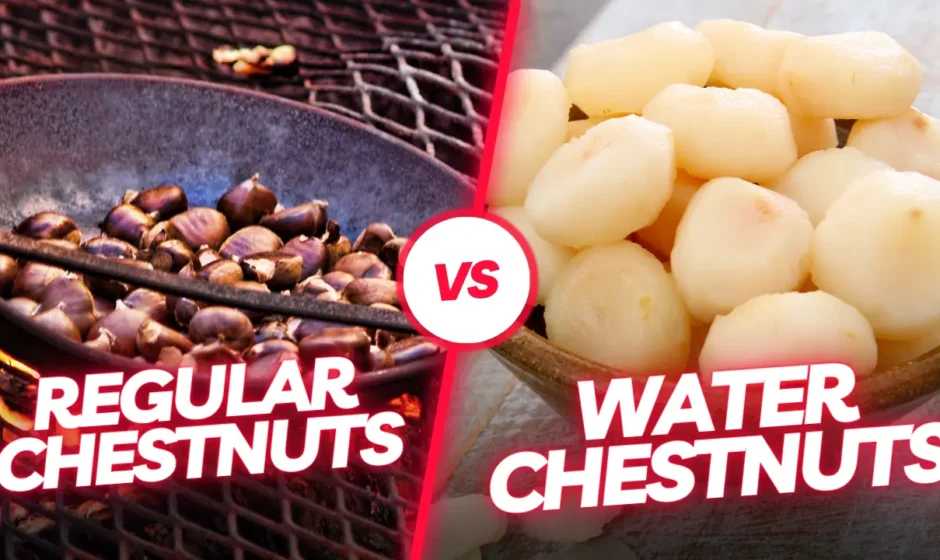Introduction
Water chestnuts and regular chestnuts have too much in common with their names. Knowing this can also help you decide what ingredient will best suit your recipe or diet. In this article, we will see the differences between water chestnuts and the regular ones when it comes to nutrition, consumption, health, etc.
What Are Water Chestnuts?
The aquatic vegetable water chestnuts (Eleocharis dulcis) grows in marshy areas and in shallow water. Although they are named nuts, they are actually the edible tubers of this water plant.
Key Characteristics
- Texture: Even after cooking, the product is crisp and crunchy.
- Flavor: Mildly sweet and refreshing.
- Appearance: It has a brown, papery skin and white flesh, which is round.
Culinary Uses
- These roots are usually used in Asian cuisine because of their crunchy texture.
- It is found in stir fries, soups, salads and desserts.
What Are Regular Chestnuts?
The usual chestnuts originate from the trees in the Castanea genus, which belong to the beech family. These are encased in spiny husks and are commonly roasted or boiled before eating.
Key Characteristics
- Texture: Soft and starchy when cooked.
- Flavor: Sweet and nutty.
- Appearance: Dark brown and glossy shell with a creamy interior.
Culinary Uses
- No other nut or seed is used more often in holiday recipes than chestnuts, as one finds in roasted chestnuts or chestnut stuffing.
- For baking, ground into flour or pureed, for soups and desserts.
Water Chestnuts vs Regular Chestnuts: A Comparison
| Feature | Water Chestnuts | Regular Chestnuts |
| Botanical Family | Aquatic herb, Cyperaceae family. | Tree nut (Fagaceae family) |
| Growing Environment | Marsh and shallow waters (in Bangladesh and Thailand) | tree grown late in temperate climates |
| Texture | Crisp, crunchy | Soft, starchy |
| Flavor | Mildly sweet, neutral | Sweet, nutty |
| Calories (per 100g) | ~97 | ~213 |
| Carbohydrates | ~23.9g | ~45g |
| Dietary Fiber | 3g | 5g |
| Protein | 1.4g | 2.4g |
| Fat Content | Almost none (~0.1g) | Low fat (~2g) |
| Common Uses | Stir-fries, salads, desserts | Roasted, pureed and baked goods, among other uses |
| Shelf Life | Shorter (2 weeks when fresh) | (Several months in shell) Longer. |
Key Nutritional Differences
1. Caloric Content
- Water Chestnuts: Low calorie option, perfect for weight management.
- Regular Chestnuts: Starchier composition means they are higher in calories ensuring an energetic mix.
2. Carbohydrates
- The carbohydrates found in water chestnuts are fewer, mainly simple sugars.
- Complex carbohydrates were a good source of sustained energy in regular chestnuts.
3. Fat and Protein
- Regular chestnuts contain a very small amount of healthy fat, while water chestnuts are nearly fat free.
- Both are low in protein, the regular chestnuts are also slightly higher.
Flavor and Texture: Culinary Implications
Water Chestnuts
- They keep their crunch after cooking and have lots of texture in dishes.
- Thanks to their subtle taste, they’re easily mixed with different ingredients.
Regular Chestnuts
- They cook so soft and creamy that they add richness to recipes.
- Sweet and nutty, they are excellent desserts and hearty dishes.
Availability and Growing Conditions
Water Chestnuts
- Grow in warm, tropical climates and water logged fields.
- Widely cultivated, mainly in Asia and especially in China and Thailand.
- Year round fresh, canned or frozen (seasonal).
Regular Chestnuts
- Temperate regions such as Europe, North America and Asia, they grow on deciduous trees.
- Available in autumn and winter, sometimes sold roasted sometimes raw.
Culinary Applications
Water Chestnuts
- Asian Dishes: Use to add some crunch to stir frys, spring roll and dumpling.
- Salads: Great sliced into salads for a little crispiness.
- Desserts: Thai desserts such as Tab Tim Grob use it.
- Flour: You can break them up and ground into a flour that’s gluten free to make pancakes or bread.
Regular Chestnuts
- Holiday Favorites: Roasted chestnuts are traditional treats in winter.
- Purees: Thus, they may be blended in soups, sauces, or spreads since they are simply protein.
- Baking: Used in cakes, muffins, breads.
- Savory Dishes: Nutty sweetens stuffing and casseroles.
Cultural Significance
Water Chestnuts
- In Asian cuisines, integral and linked with the prosperity, in Chinese culture.
- Considered cooling and detoxifying in ancestral medicine.
Regular Chestnuts
- Roasted chestnuts appear in European holiday traditions with feature prominence.
- For generations chestnut flour was a staple food in Italy and France and was eaten when food was scarce.
Health Benefits Comparison
Water Chestnuts
- Hydration: Hydration can be promoted by a high water content.
- Low-Calorie: Ideal for weight management.
- Digestive Health: A great source of fiber for overall gut health.
Regular Chestnuts
- Energy Source: Rich source of complex carbs for long term energy.
- Bone Health: It contains magnesium and phosphorus.
- Antioxidants: High in vitamin C and other antioxidants.
Environmental Impact
Water Chestnuts
- It is considered an environmentally friendly crop which is great in wetlands.
- The ecological footprint of other comparable vegetables is minimal.
Regular Chestnuts
- Reforestation and soil stabilization can come from chestnut trees, but there are other benefits as well.
- Sustainable agriculture depends on the long lifespan of trees.
Which One Should You Choose?
Choose Water Chestnuts If:
- What you need is a low calorie, hydrating ingredient.
- You’re looking for something to add some crunch and texture to your meals.
- You’re a little more subdued, not so exciting.
Choose Regular Chestnuts If:
- If you’re looking for sweet, nutty flavor to include in desserts or holiday dishes, then this is the spice for you.
- What you need is a starchy and energy dense ingredient.
- Roasted snacks or hearty purees are your thing.
Conclusion
For all intents and purpose, water chestnuts and regular chestnuts share a name yet possess very distinct characteristics and as such, applicable to wholly different culinary uses. In a stir fry, they provide a nice crunch, and regular roast chestnuts are sweet and rich. Knowing the difference in between these versatile ingredients will help you to make the best use of them in your kitchen.


